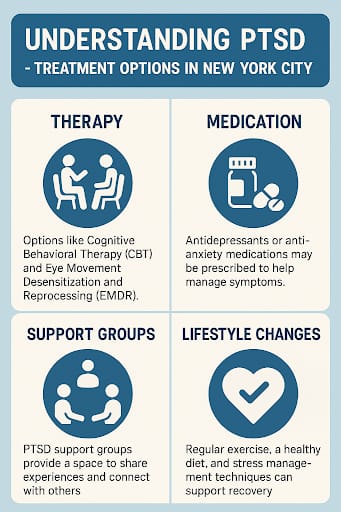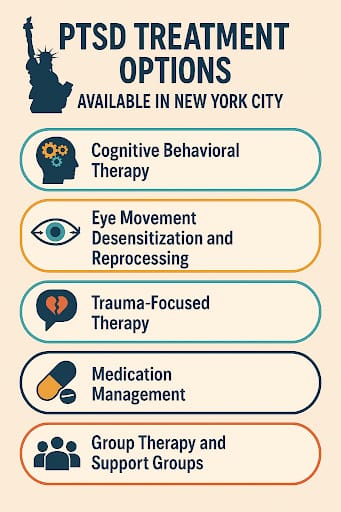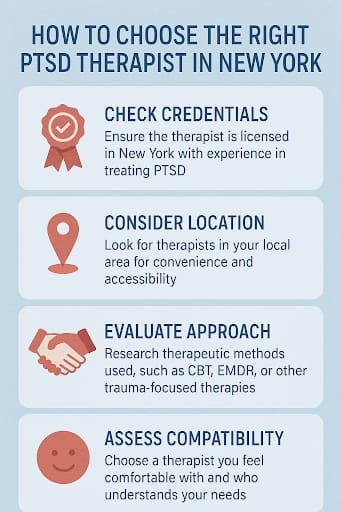
INTRODUCTION
Post-Traumatic Stress Disorder (PTSD) is much more than a mental health condition- it is a deep, sometimes life-changing reaction to trauma. Trauma can come from military service, sexual or physical assault, natural disasters, or witnessing violence. PTSD can compromise one’s emotional, psychological, and physical health in major ways.
People living with PTSD can find treatments and care in New York City, a city with a strong mental health infrastructure and numerous types of effective treatment options for PTSD. In this blog, we are going to look at what PTSD is, how it manifests, and the many treatment options in NYC for support and healing.
What Is PTSD?
Posttraumatic stress disorder (PTSD) is a psychiatric disorder. It can develop when the person has experienced a traumatic event. PTSD is characterized by a constellation of symptoms that can impact cognition, emotion, physical health, and behavior.
PTSD is a chronic source of psychological distress that can lead to the co-occurrence of other psychiatric conditions, and increases the risk of suicide. Being involved in a traumatic event, whether it is the result of war, natural disaster, serious accident, and/or sexual violence (among others) can provoke extreme fear and distress.
While the vast majority of individuals eventually recover from trauma over time, some go on to experience a more enduring mental health condition (e.g., PTSD, depression, anxiety disorders, or substance use disorder). Globally, it is estimated that approximately 70% of individuals experience at least one potentially traumatic event in their lifetime.
Symptoms of PTSD
Posttraumatic stress disorder (PTSD) symptoms are categorized into four main types.
- Intrusion symptoms are characterized by flashbacks, nightmares, and persistent intrusive thoughts.
- Avoidance symptoms are defined as avoiding anything related to the trauma (people, places, discussions), often accompanied by emotional numbness.
- Negative alterations in mood and cognition may include negative-thinking patterns, guilt, shame, feelings of detachment, and loss of interest or pleasure in activities that once were enjoyed.
- Hyper-arousal symptoms include irritability, being easily startled, difficulty sleeping, and constant feeling of tension.
These symptoms can appear in the first two months following the trauma, but some symptoms can take years to be manifest, and can fluctuate in nature, and can be activated by reminders of the traumatic event.
Why Seeking Treatment is Crucial?
Getting treatment for posttraumatic stress disorder (PTSD) is very important because untreated PTSD can interfere with an individual’s life and quality of life, personal relationships, job responsibilities and performance, and physical health.
PTSD also commonly co-occurs with other mental health conditions including depression, anxiety, substance use disorders, and suicidal thoughts. Early treatment and consistent treatment provides individuals with an opportunity to take back their life, develop coping skills to use, and reduce emotional distress.
Treatment also reduces communication and relationship difficulties, and sense of isolation by connecting the individual with other people and support systems. The goal of timely treatment is to allow individuals to recover and sustain their recovery in the long-term.
PTSD Treatment Option Available in New York City

1. Cognitive Behavioral Therapy
Cognitive Behavioral Therapy (CBT) is the most commonly used evidenced based approach and intervention for treatment of posttraumatic stress disorder (PTSD).
- CBT works to help people recognize and change negative thought patterns and behaviors regarding their traumatic experiences. In CBT, maladaptive thought patterns contribute to the symptoms of PTSD and produce negative coping methods and emotional regulation.
- Two popular versions of CBT used in treatment of PTSD include Cognitive Processing Therapy (CPT) and Prolonged Exposure Therapy (PE). CPT focuses on recognizing and challenging unhelpful beliefs about the trauma accumulated related to their experiences.
- PE involves safely confronting through gradual exposure of trauma characters, memories, and triggers.
- Both therapies are designed to help decrease distress and allow time for recovery long-term.
2. Eye Movement Desensitization and Reprocessing
Eye Movement Desensitization and Reprocessing (EMDR) is an effective way to treat PTSD. EMDR is best known for combining guided eye movement and recalling traumatic memories to help the brain reprocess and reframe how traumatic memories are stored in the brain.
- The purpose of EMDR is to help lower the painful emotional experience of trauma memories by lowering emotional intensity and vividness.
- EMDR does not rely on individuals recounting their traumatic experiences through verbal discussions.
- This is particularly helpful for those who may have difficulty verbally sharing their experiences.
- EMDR has been shown to work effectively with both single-event trauma and complex, long-standing trauma, with great results and emotional relief, while improving one’s emotional regulation.
3. Trauma Focused Therapy
Trauma-focused therapy is a specific type of treatment designed to address trauma’s psychological impact.
- Trauma-focused therapies are specifically designed to help the individual process trauma-related experiences where emotional and sentient balance can be regained.
- These therapies utilize several approaches including those of Cognitive Behavioral Therapy (CBT), mindfulness, somatic therapies (mind and body), etc.
- Examples include, but are not limited to, Sensorimotor Psychotherapy which focuses on body awareness and body movement; Internal Family Systems (IFS) which investigates parts (or emotional aspects) of the self that fosters self-compassion.
- Trauma-focused approaches address the emotional and physiological influences of trauma, which creates and fosters healing.
4. Medication Management
Medication management is a supportive aspect of treatment for posttraumatic stress disorder (PTSD), in particular, when symptoms, including anxiety, depression, or inability to sleep, are so severe that therapeutic interventions are limited or irrelevant.
- Treatment for PTSD remains primarily psychiatric therapy, with several medications available to lessen symptoms and impact on other functionalities in daily life activities.
- Examples of medications most prescribed include: selective serotonin reuptake inhibitors (SSRIs) such as sertraline and paroxetine and serotonin-norepinephrine reuptake inhibitors (SNRIs) such as venlafaxine.
- Prazosin is usually prescribed for trauma related nightmares.
- Mood stabilizers or anti-anxiety medications may also be prescribed where PTSD occurs with other comorbid conditions.
Overall, any medication management strategy should be individualized, developed with and through a healthcare provider, to maximize the positive outcomes of treatment.
5. Group Therapy and Support Groups
Group therapy and support groups are important resources for people with PTSD to connect with others who have been through similar trauma.
- Sharing your experiences with other people in a supportive group setting supports you in feeling less alone and/or isolated, and promotes the belief that you belong.
- You may find that being part of a group helps you feel heard and accepted. This is an important healing element.
- Being part of a group exposes you to the ways others cope and what other perspectives they use.
- Group therapy also provides you with the opportunity to practice sharing and communicating positively with others about your experiences, including how you cope and regulate emotions.
- Group therapy can further enhance mutual support among group members, combined with the ongoing support that individual therapy provides, it can provide a substantial benefit to your recovery.
How to Choose the Right PTSD Therapist in New York

Finding the right PTSD therapist in New York City takes some thinking to make sure you get the compassion and effective care that you need.
- First, check the credentials of potential therapists—look for licensed providers such as LCSW’s, PhD’s, PsyD’s, or LMHC’s who are versed in trauma-focused therapy approaches.
- Ask what treatment strategies they use and if they use any evidence-based modalities like CBT, EMDR, or trauma informed care.
- Additionally, it is also important that you find someone who is culturally aware and take into account your culture, identity, and values.
- Finally, look to see where the therapist is located and what their availability is.
- Being able to access the therapist easily will help you maintain consistency. Resources like Psychology Today or Therapy Den, can make this search easier.
Final Thought
PTSD is a complicated disorder, but there are many effective and available treatments in NYC. There are important things to remember about PTSD treatment in New York City.
- First, there are many evidence-based treatment approaches related to PTSD, such as CBT, EMDR as well as trauma informed approaches and pharmacological options as well as supportive group therapy.
- Second, People need comprehensive and coordinated care when it comes to their treatment.
- The third factor to consider is that early intervention and treatment of PTSD will help clients reclaim their autonomy, well-being, and resiliency.
Reference
- Mann, S. K., Marwaha, R., & Torrico, T. J. (2024, February 25). Posttraumatic stress disorder. StatPearls – NCBI Bookshelf. https://www.ncbi.nlm.nih.gov/books/NBK559129/
- What is Posttraumatic Stress Disorder (PTSD)? (n.d.). https://www.psychiatry.org/patients-families/ptsd/what-is-ptsd
- World Health Organization: WHO. (2024, May 27). Post-traumatic stress disorder. https://www.who.int/news-room/fact-sheets/detail/post-traumatic-stress-disorder
- Kar, N. (2011). Cognitive behavioral therapy for the treatment of post-traumatic stress disorder: A review. Neuropsychiatric Disease and Treatment, 7, 167. https://doi.org/10.2147/NDT.S10389
- Vereecken, S., & Corso, G. (2024). Revisiting Eye Movement Desensitization and Reprocessing Therapy for Post-traumatic Stress Disorder: A Systematic Review and Discussion of the American Psychological Association’s 2017 Recommendations. Cureus, 16(4), e58767. https://doi.org/10.7759/cureus.58767
- Watkins, L. E., Sprang, K. R., & Rothbaum, B. O. (2018). Treating PTSD: A Review of Evidence-Based Psychotherapy Interventions. Frontiers in Behavioral Neuroscience, 12, 258. https://doi.org/10.3389/fnbeh.2018.00258






